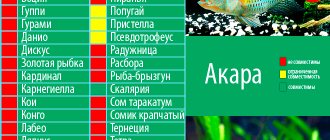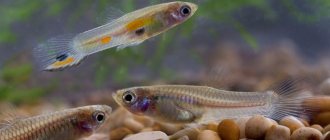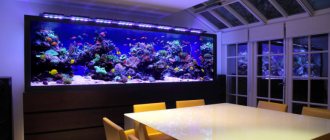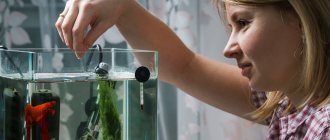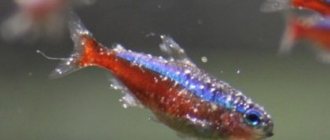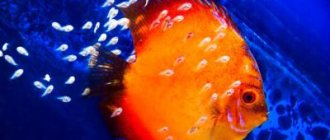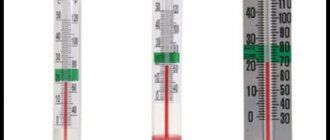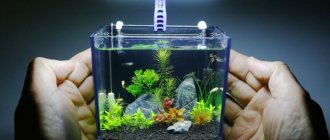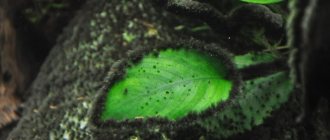Guppy
These representatives of the aquatic world are known to almost everyone. They are an excellent option for beginners in fish breeding, as they are completely undemanding in care, but at the same time very decorative.
Male guppies are especially attractive, as they have unique variegated colors and incredibly beautiful tails, which cannot be said about females, which, although they reach 6 cm in length, are colored gray or silver, and their tails are small and unremarkable. Male guppies range in size from 1.5–3 cm.
The crazy popularity of these aquarium inhabitants is due to the ease of their maintenance and breeding. A 15-30 liter aquarium is enough for 5-7 fish to feel comfortable in it.
Find out more about guppies: rules for caring for the most common aquarium fish.
The issue of aeration and filtration in this case can be easily resolved with the help of special living vegetation, as well as regular water changes and soil cleaning. 1/3 of the water must be replaced every 7 days. The water temperature in the aquarium should be within +18…+30 °C. It is very useful for these fish to add table salt to the aquarium at the rate of 1 tsp. for 10 liters of water.
As additional lighting in the evening, you can use a regular table lamp.
Important! The more sunlight and artificial light male guppies receive, the brighter and more saturated their color will be.
Despite their tiny size, these little ones are almost always hungry and completely unpretentious in food. Both live plant food and special food from pet stores are suitable for feeding.
Guppies are viviparous fish, that is, females do not lay eggs, but immediately fry, which can develop and feed independently. This greatly simplifies their breeding at home, since it does not require the participation of an aquarist in this matter.
The best neighbors for guppies will be small and peaceful fish.
This is interesting: Top of the best peaceful and predatory fish for the home aquarium (7+7)
Guppies are the most unpretentious type of fish for an aquarium.
For people who want to breed fish at home, guppies are often recommended in pet stores. These small pets are ideal for beginner aquarists. Even busy owners who are often on business trips can breed them. These fish can go without food for about a week. They are also unpretentious to the environment in which they are kept. The main conditions for their existence are clean water and a sufficient size of the aquarium.
Guppies can easily tolerate temperature changes. But when breeding these fish it is worth remembering the following:
- the minimum water temperature can reach 18°C;
- the optimal temperature for guppies is 24°C;
- maximum temperature – 30°C;
- suitable water temperature during spawning is 27°C.
Guppies have bright colors, which makes them very popular. Males are smaller in size and brighter in color. Females are not as attractive and are slightly larger than males.
Guppies breed well in an aquarium. The female produces fry that are capable of feeding on their own. If you feed the fish poorly, the parents will satisfy the hunger of their offspring. Therefore, when breeding, it is better to keep guppy fry in a separate aquarium.
Guppies are very calm fish. They love to eat plant foods, so it is advisable to breed algae in the aquarium. Proximity to larger, faster species can be detrimental to guppies.
Swordtails
These fish are also very popular because of their unpretentiousness and decorativeness. In captivity, the maximum length of males is 11 cm, and females - 12 cm. They owe their name to the long growth on the lower fin of males, which resembles a sword.
These fish can have a wide variety of colors; they are yellow, white, green, black, spotted and red, and the most common color is considered to be red with a black caudal fin.
Swordtails are very active, therefore, the more space they have, the more comfortable they will feel; a 35 liter aquarium is suitable for keeping one male, but a larger volume of water is always welcome. As for the quality of water, it should have an average pH level of 6.8-7.8, with average hardness, and its temperature should be within +23-25 °C.
Important! Experienced aquarists recommend keeping one male swordtail and 2-3 females. The presence of 2 males in the same territory leads to conflicts.
You can feed swordtails with any food: live, plant-based, frozen, and dry. It all depends on what is more convenient for you, because these fish are absolutely not picky about food.
Since male swordtails have a changeable character and can sometimes behave aggressively, it is better to properly plan their proximity in a common aquarium. They will definitely get along with fish such as guppies, gouramis, angelfish, mollies and neons.
Check out the lists of red and black aquarium fish.
Other common tenacious fish
Macropods (paradise fish) have long been known aquarium beauties. Fragile-looking fish are very hardy. One of the most durable - conditions are not important for them, they even do without aeration and a filter. They are easy to care for. Various colors, iridescent stripes on the sides, flexible movements, beautiful fins attract attention. In aquariums, girls reach 10 cm, boys - 12 cm, in nature they are much larger. Despite their sophisticated appearance, these fish often show aggression. Cocky males are capable of killing competitors. It is better to keep them in pairs; it is permissible to add them to schools of small fish.
Bettas (Siamese fighting fish) are spectacular, bright, memorable pets. Regular exhibitors. The fins are large and veiled. The colors amaze with their depth and variety of combinations. They are unpretentious in maintenance and cope well in different conditions. The fish are very aggressive towards representatives of their own species, so it is impossible to keep two cockerels in the same territory. They are also hostile to other aquarium inhabitants.
We recommend reading
Astronotuses: care and maintenance
It's safer to keep him separate from everyone else. It is acceptable to be placed with nimble, medium-sized fish (swordtails, minors), with caution placed with guppies, cardinals, barbs, since daring cockerels tend to start fights, bite and tear off the fins of their neighbors.
Mollies
The name mollies combines several species of fish that belong to the genus Pecilia and differ in shape and color. On average, males reach 6 cm in length, and females - 8 cm. Their sex is very easy to distinguish, since they are viviparous, in which the distinctive feature of males is the gonopodium.
It is not at all difficult to create optimal conditions for their existence; a 50-liter aquarium will be enough for a small group of fish, but at the same time, the more space the mollies have, the better. Their water requirements are completely moderate; it is enough that it is slightly alkaline and its temperature varies between +25-27 °C. Every 7 days it is recommended to replace ¼ of the volume of water in the aquarium with fresh water at the same temperature. Good aeration and filtration are mandatory requirements for the favorable maintenance of mollies.
These fish are omnivores, so there are no problems with feeding them; they can be fed with both plant and live and dry food. The main thing is not to overfeed them and provide a balanced diet.
Mollies are quite calm, they do not conflict with each other and get along well with other fish that are a little larger or the same size as them, and also have a peaceful disposition. Ideal neighbors for them can be swordtails, gouramis, angelfish, cockerels and laliuses.
Learn how to care for mollies in an aquarium.
Ancistrus
Unpretentious aquarium fish catfish - ancistrus are able to stick to any surface thanks to a modified mouthparts equipped with a suction cup.
The basis of their diet is fouling on walls and decorative elements, which they scrape from surfaces, thereby clearing them of contaminants. This is an excellent way out for those who do not have time to clean the aquarium themselves.
The water temperature required for catfish – “stuck” – is +20°C - +28°C. And the volume of the aquarium must be selected depending on the number of individuals (at least 50 liters).
The average lifespan of ancistrus is 7 years. During this time, its size can reach 10 cm.
The catfish's digestive system requires cellulose, so driftwood must be present in its home. At the same time, they like plant foods, including some types of vegetables (pumpkin, zucchini, cucumber). But aquarium algae can also be affected.
A male and female ancistrus, being in the same container, are quite capable of reproducing offspring. At the same time, they are loyal to other species of fish and practically do not show aggression towards them.
Ternetia
This is a small dark-silver fish that reaches a length of 4-5 cm. The hallmark of the thornia is its body flattened on the sides, which makes it unusual and sophisticated.
She is gregarious and peaceful.
Important! The color of the thornfish can change due to changes in the chemical composition and temperature of the water; the fish can be almost transparent or deep black.
Due to the fact that these fish are schooling, it is recommended to keep them in groups of 5-7 pieces; accordingly, they need to be provided with space to move; a 50-liter aquarium is perfect for this. Comfortable water temperature for thorns is +21-24 °C. The water should be of medium hardness with a pH level of 6 to 7. It is also necessary to ensure good filtration and aeration. ¼ of the water needs to be changed every week.
In terms of nutrition, thorns are completely unpretentious; they can be fed with plant, animal and dry food.
Ternetias get along well in a community aquarium with small, non-aggressive fish, for example, guppies, gouramis, angelfish and swordtails.
The most unpretentious catfish
| 60 (for young fish 2-2.5 cm) Most beginners consider it their duty to purchase a “catfish” to clean the bottom of various residues and rummage in the ground. In part, this is not a bad idea, but pet stores sell many types of catfish that are approximately the same at first glance, which can grow into large and capricious fish. But for a small beginner’s aquarium, the catfish of the Corydoras genus, namely the speckled catfish, is best suited. This is an omnivorous fish, reaching a maximum length of 7 cm (females are slightly larger than males). They are quite peaceful and can form flocks. They are actively digging the soil, so powerful filtration will be required. The minimum volume of the aquarium is 50 liters, the optimal water temperature is 20-24°C, pH 6.5-8, hardness 4-35°. Main advantages:
Minuses: muddies the water a lot. | 9.6 / 10 Rating Reviews The main advantage of this catfish is that it can be kept even in a small aquarium. It is unpretentious in food, loves to dig in shallow soil, and cleans the bottom. |
Popular articles Assembling a custom water cooling system with your own hands (makeshift for pennies)
Angelfish
These fish belong to the Cichlid family. They are distinguished by their beauty and unpretentiousness. Adult angelfish grow up to 15 cm in length and 25 cm in height. Their body is flattened on the sides. Their ventral fin is elongated, and their dorsal and anal fins resemble a crescent. There are a huge number of species of these fish, which, in turn, differ in both external features and colors. The color of angelfish can also change depending on the conditions in which they are kept, namely: on the quality of water, food, and the amount of light in the aquarium.
In order to have such fish, you will need a high (from 45 cm) and voluminous (from 100 l) aquarium. The water temperature should be in the range of +25-27 °C, of medium hardness, with a pH value in the range of 6.5-7.5.
Important! For angelfish it is necessary to provide good lighting; lack of light or sudden changes in lighting cause discomfort in the fish.
These aquarium inhabitants should be fed with live food; bloodworms, daphnia and tubifex are perfect for this.
In a community aquarium, angelfish will get along well even with small fish; the main condition is that the neighbors be peaceful. It is not recommended to place them in the same aquarium with guppies, neons and goldfish.
The most unpretentious
The smaller the volume of the aquarium, the more difficult it is to maintain biological balance in it, and complex design “delights”, even when using the best filtration, aeration, and cleaning systems, also suffer from this drawback. But fortunately, there are a huge number of truly “unkillable” fish, ready to live tolerably even in a jar of homemade twists. If you make a top list of the most unpretentious aquarium fish, the guppy will top it.
Guppy
Many experienced aquarists recall that the hobby began with an aquarium with guppy. In all sources, guppies are characterized as the most unpretentious. To keep them, a small aquarium is possible - 15-35 liters per flock of 6-8 pieces. And “Venezuela” guppies live in 10-20 liter containers.
In nature, guppies even live in wetlands, where they successfully fight yellow fever by eating the larvae of malaria mosquitoes. In the swamps, the water level is low, so the temperature changes are significant, there is little oxygen, but the fish grow and reproduce even in such harsh conditions.
Aquarium hybrids are more demanding than their wild relatives, but they can also withstand:
- temperature fluctuations from 15 to 36°C, but the optimal range is 23-27°C;
- lack of aeration - it is enough to plant live plants in the aquarium and change the water more often;
- different lighting - for a small aquarium you can limit yourself to a table lamp in the evening. During the day there is enough light from the window;
- no food for 7 days. In general, guppies are undemanding when it comes to nutrition - they eat plant and animal food with equal success, and can eat dry industrial food.
Fish are found in the rivers of our country, near drains, where they come from sewers. Undemanding nature, ease of reproduction, and fertility determine the use of guppies in experiments by geneticists, immunologists, and toxicologists. But if you set a goal not just to keep guppies, but to breed bright fish with unusual fins, then you need to adhere to certain conditions.
The first living creatures that the Soviet Union sent into space were guppies. They not only felt comfortable in conditions of weightlessness, but also managed to give birth to viable offspring, which were safely delivered to Earth and studied in a secret laboratory. Later, swordtails found themselves in space - they are second in the list of the most unpretentious aquarium fish.
Swordtails
Swordtails are somewhat larger than gupeshkas, so the aquarium for keeping them must be larger. The minimum volume is from 30 l, the optimal is 50 l. The fish are undemanding to water parameters. They carry:
- short-term decrease in water temperature to + 15°C;
- increasing rigidity;
- lack of aeration.
A small amount of green plants will help maintain tolerable living conditions. However, prolonged maintenance in such spartan conditions will lead to discoloration of the fish and a decrease in fertility. Swordtails feel tolerable even with rare water changes. If it is not possible to replace 1/5 of the volume more frequently, it can be done once every 2-3 weeks.
They are as unpretentious in nutrition as guppies. They eat dry and live food. They can do without plant nutrition for a long time, gnawing algae deposits and plant leaves. There are no problems in breeding swordtails. You can also place a pregnant female in a three-liter jar for the period of birth of the fry. Fully formed and active fry are born and do not require special care or starter feed.
Aquarium catfish
Corydoras catfish occupy an honorable third place in the ranking of the most unpretentious aquarium fish. They are not only able to go without food for a long time, but also gnaw algae covering the walls of the aquarium as food, eat leftover food, cleaning the soil.
Like the previous leaders of the top, catfish can do without aeration, since they have intestinal respiration - in addition to gill respiration. Thanks to this device, they can breathe atmospheric air. When the level of dissolved oxygen in the water decreases, they rise to the surface and swallow air. It enters the intestines. Part of it is devoid of digestive glands and is penetrated by a dense network of blood vessels. Gas exchange occurs through their walls.
Decorative catfish are the most peaceful creatures. By adding them to the aquarium, you can be sure that all the inhabitants will remain completely safe. The offspring of these sweet creatures do not require the care of an aquarist. It is difficult to find more loving and caring parents. For 9-15 years, night “cleaners” will help maintain the cleanliness of the aquarium and delight with their original appearance, “conversations” and interesting behavior.
Mollies
In fourth place are mollies. They, like guppies, swordtails are ovoviviparous. With this group of fish, nature has tested all sorts of adaptation systems that allow them to adapt as much as possible to difficult living conditions. Even viviparity is a way to preserve the majority of offspring, since only the newly born fry actively seek shelter.
The fish are very mobile, so they require large aquariums, but can be kept in containers of about 50 liters. Just like the previous species, they are very hardy and easily adapt to changing conditions. However, they are more picky regarding water temperature. It should not fall below 25°C, but it is better that it averages 27°C.
The less wild fish left in mollies breeds, the more difficult it is to keep them. Veil-finned specimens are very sensitive to water characteristics and are therefore not recommended for inexperienced aquarists. Mollies are omnivores - they eat dry and fresh food. For good health, you need to supplement your diet with herbal supplements.
Characin tetras
Fifth place is occupied by small, active characinx tetras. They tolerate normal water conditions, standard food and a small aquarium volume well. But the harsh conditions that guppies and swordtails easily survive can lead to the death of characins.
Ternetia
The further we move away from the first place, the less hardy and unpretentious the fish can be considered. The sixth place is occupied by thorns. These bright small fish have acclimatized in artificial home reservoirs, where they reproduce successfully and easily.
Cockerels
These beautiful aquarium fish, classified as labyrinths, also have epibranchial respiratory organs, which allows them to exist in an aquatic environment poor in oxygen. They can breathe atmospheric air using a labyrinth, but the aquarium must be designed so that the fish can swim to the surface and swallow air bubbles. Therefore, they do not require aeration.
In addition, the betta can live in a limited volume of 3-10 liters. But this does not mean that it is necessary to torture the fish, otherwise their fins will stop growing. Cockerels are also loyal to water temperature - for a short time they can tolerate +18°C, but 24-30°C is comfortable. Hardness – 2-12°, pH 6.0-7.5 – regular tap water, only settled, will do.
Danio rerio
Small fish that grow in captivity up to 6 cm in length, but despite their tiny forms, they are valued for their incredible decorativeness. On the silver body of the zebrafish there are blue horizontal stripes that shimmer with all the colors of the rainbow in good lighting. With age, the fins of these fish become veil-shaped.
Danio rerio are undemanding when it comes to aquarium volume, so you can keep a small flock even in a 10-15 liter container. The quality of water is not particularly important for them; ideally it should have a neutral pH. The water temperature can vary between +15…+30 °C.
These fish love to eat; live food is a real delicacy for them, but if this is not available, dry medium-sized food is also suitable.
Learn more about breeding zebrafish, zebrafish.
An aquarium with zebrafish must be covered, as these fish love to frolic and jump out of the water, which can play a cruel joke on them if they are not returned to the aquarium in a timely manner, and to prevent such misunderstandings, simply cover the container with a lid or glass.
Danio rerio gets along well with almost all fish, the main thing is that they have the same requirements for water parameters.
Did you know? Scientists have discovered an enzyme in the stem cells of zebrafish, on the basis of which they believe it is possible to quickly create an effective cure for melanoma (skin cancer).
Macropod
Macropods are quite unpretentious fish; a couple of fish can be kept in a 15-liter aquarium. The water temperature range is 15-30 degrees. As the temperature drops, the color of the fish becomes less bright and activity decreases. Macropods have the most beautiful appearance during spawning; in general, representatives of this species grow up to 12.5 cm, they are quite aggressive and territorial, so it is not recommended to keep them with other species. Fish breathe atmospheric air, the quality of water is not too important for them; they can be fed with dry mixtures or live food.
Cockerels
Beautiful and unpretentious fish with a difficult character, it is because of the aggressive behavior of the males that they got their name. Their sizes are very miniature, length does not exceed 5 cm. Now there is an incredible number of color variations of these aquarium inhabitants that appeared during selection, and initially the cockerels were silver or olive in color.
Even a 5-liter aquarium is suitable for keeping one male, and if we are talking about a small group, then more space will be needed, especially since keeping 2 or 3 males in one, and even a small area, is not recommended, due to their aggressive nature . These fish are thermophilic, so it is important to maintain the water temperature in the aquarium so that it varies between +24-28 °C. The water should be of medium hardness, 6.0 – 7.0 pH. In order for the cockerels to be comfortable, you should arrange the aquarium so that it contains a lot of large-leaved plants, but in no case waterfowl. It is also worth taking care of good lighting.
Cockerels are fed with live and non-living food; their diet may contain bloodworms, tubifex, daphnia, shrimp meat, ground beef or fish, zooplankton, and snails. It is worth noting that these fish are prone to obesity, so overfeeding them is not recommended.
The best aquarium neighbors for them will be small, fast fish, but keeping them with any veil-tailed fish or predators should be avoided.
Did you know? Pisces communicate with each other using ultraviolet light; it has been scientifically proven that visual contact occurs between them, in which the ultraviolet component plays a fundamental role.
Types of fish that live without oxygen
I would like to note that there is not a single living creature that can continue its life without air. However, among aquarium fish there are representatives that can not breathe oxygen dissolved in aquarium water, but receive it from atmospheric air. Macropods, loaches and labyrinths are able to grab air from the surface of the water and retain it in their body for some time.
Loaches can take air into their intestines. One of the brightest representatives of such fish is the Corydoras catfish. These are small fish, about 3–7 cm in size. They have a shell made of bony plates on their back. The most common color is gray-olive. These are peaceful fish that get along well with other representatives. They love to hide in shelters and often dig up the soil in which they look for food.
Popular articles Talking parrots: the best breeds for home, care features
The average lifespan of this type of catfish is 10–12 years.
Macropod and labyrinthine fish species have a special gill structure, which also allows them to swallow air from the surface. Let's look at the most unpretentious and common representatives.
Gourami
Peaceful fish, about 5–12 cm in size. There are a lot of varieties: pearl, moon, blue, kissing, grumbling, marble, gold, chocolate gourami. The names of the species speak for themselves - these fish are varied in color.
Among the general recommendations, I would like to highlight the following. The aquarium must be at least 50 cm long and have a volume of at least 50 liters. Fish need space to hide and play.
They are unpretentious in food, they eat different types of food, however, it is important not to overfeed them. They need floating plants to spawn.
Lyalius
Small fish, about 7 cm in size. Shy, it is best to keep a flock of at least 3 fish. They can even live in a small aquarium with a volume of about 10 liters. However, for comfort it is better to purchase a larger container. They get along well where there is a lot of algae and vegetation, because they like to hide.
betta cockerel
Very beautiful fish, however, they are aggressive and do not get along well with their neighbors. One fish needs 5–10 liters of water. Cockerels are omnivores. There are special feed mixtures for them on sale. There must be vegetation in the aquarium so that the females have a place to hide during spawning, as well as from an aggressive male.
Labioses
These are large, quiet fish. They need a minimum of 10 liters of water per inhabitant. They love algae very much. They prefer small, varied food
When breeding them, special attention should be paid to the temperature regime in the aquarium. A comfortable temperature for them is +25–28 degrees
Macropods
Hardy fish that can live even in a three-liter jar. They tolerate cold and spoiled water. Macropods are pugnacious and do not like smaller neighbors. They are unpretentious in food and omnivorous. For soil it is better to use expanded clay and coarse sand.
The aquarium must have a lid that does not block access to air. In addition, the ideal option would be if the surface of the water is covered with algae.
Acantophthalmus
This fish is quite difficult to care for. They prefer small aquariums. Shelters are needed - stones, snags, castles. Such fish can jump out, so open aquariums are not allowed. Breeding them is difficult even for professionals. In food, they can be content with microorganisms from the soil and waste from the rest of the population of the aquarium, however, they will be happy with live and frozen delicacies.
Common spined loach
This fish is called a home barometer, since its restless behavior predicts the onset of bad weather. They are unpretentious and can live in an aquarium of 10 liters or more. There are also no special requirements for temperature; it can range from +3 to +30 degrees. The soil can be either large or small. It is not recommended to use sharp aquarium decorations.
In general, there are many fish that do not require an aquarium with a filter and aeration to survive. Take into account the size and character of the pets, as well as the water temperature and soil quality, and then the fish will be comfortable coexisting together.
Gourami
Some of the most popular aquarium inhabitants around the world are known for their unusual appearance. The pectoral fins of gourami look like long whiskers, which are an organ of touch; with their help, they feel the food and everything that surrounds them.
The length of adult fish is 13-15 cm, and the colors can be varied.
Find out more about gourami: habitat, description and compatibility in the aquarium, care; species of pearl gourami.
Due to the fact that gourami are quite large, it is better to choose an aquarium with a volume of 70-100 liters for keeping them. They are not too demanding on the quality of water, but it is imperative to maintain its temperature within +24-26 °C and ensure that the pH is around 7.0. The aquarium should have good lighting and enough live plants.
Gourami love to jump out of the water, so you should take care of a lid or glass for the aquarium.
There will be no problems with feeding, these fish eat both live and dry food, it is better to alternate them, as a result the pets will have a balanced diet.
Gourami are compatible with almost all small and peace-loving fish. Ideal would be proximity to angelfish, zebrafish, mollies, swordtails and botia.
We advise you to read about maintaining the temperature and water hardness in the aquarium.
Corridoras
These are small armored catfish that are small in size: from 3 to 12 centimeters. A special feature of this species is the ability to breathe atmospherically, therefore, when setting up an aquarium, it is necessary to provide free access for catfish to the surface of the water. It is best to keep Corydoras in groups; make sure there are plants and shelters. They are not too demanding on the quality of water; the temperature can range from 17 to 32 degrees. These are bottom-dwelling fish, so food must be selected so that it falls to the bottom. 30% of the total volume of the aquarium needs to be changed regularly.
Barbs
These active fish, painted in bright colors, will certainly please the eye, and they are also very easy to keep in the aquarium. The size of barbs does not exceed 4-6 cm, their body resembles an elongated oval, and they can be painted in a variety of colors.
Due to the fact that the fish are very active, you should choose a spacious aquarium for them (50-70 liters), preferably an elongated one. They are completely undemanding regarding the quality of water, that is, its chemical parameters, but its temperature should be maintained within +22-26 °C. Water changes are carried out once every seven days by 1/3. It is important to provide the fish with good filtration and aeration.
Important! Barbs are schooling fish, so you should keep them in groups of at least 5-7 individuals.
These fish are omnivores, so you can feed them with live, plant-based, and dry food. The main thing is not to overfeed them, as they are famous for their tendency to become obese. Experienced aquarists recommend arranging a fasting day for barbs once a week.
These fish are quite peaceful, despite their activity, so they easily get along with small and friendly neighbors. The only exceptions are veil-tailed ones.
Carp
Representatives of the Karpov family are frequent residents of freshwater domestic ponds. In addition to colorful and bright colors, carp fish are known for their endurance and unpretentiousness - representatives easily adapt to different living conditions.
Among the representatives of the Carp family, the most unpretentious fish are the following:
- Barbs - barbs do not exceed 10 cm in length. They are distinguished by their mobility and nimbleness, and love to bully neighbors in the aquarium, pestering fish with long fins. Of the many varieties, Sumatran and cherry barbs are considered unpretentious.
- Danios - include many varieties, among which zebrafish and pink danios are popular. The fish do not differ in size - the length of the representatives does not exceed 7 cm.
- Cardinals are miniature bright fish up to 4 cm long. They live in a school of relatives and are easy to reproduce and maintain. In addition, cardinals are quiet and peaceful phenotypes that get along well with other varieties.
Catfish Corydoras
These fish have a rounded body and a convex back, they are colored gray or olive and covered with black or dark spots. Corydoras catfish are not at all capricious and even a beginner can breed them.
It is worth noting that these pets are school animals, so they need to be kept in groups of 5-7 individuals. The aquarium in which they will live should be spacious: from 50 to 70 liters. Comfortable water temperature for them ranges from +16...+25 °C. The chemical composition of the water is not particularly important. It is advisable to ensure good filtration and water changes every 7 days by 20%. The soil in the aquarium in which Corydoras catfish live should be shallow and soft. Numerous plants are welcome, especially floating ones.
Corydoras catfish are absolutely not picky about food; they eat everything they find at the bottom. But it is important to ensure that the fish do not starve if they are kept in a community aquarium.
Corydoras are excellent neighbors with almost all small fish; they are very friendly and peaceful. Incompatibility of these catfish with anyone else can only arise in cases where the fish have different preferences for water quality.
Did you know? The dimensions of the smallest aquarium in the world are only 30x24x14 mm with a water volume of 10 ml. It’s surprising, but real fish also live in this miniature. Anatoly and Stanislav Konenko managed to create such a tiny house for waterfowl pets.
Catfish
Catfish are called aquarium orderlies, since pets bring great benefits by cleaning the tank from food residues and algae. Catfish are hardy and tenacious, have a quiet disposition and do not bother their neighbors. Popular unpretentious species for the aquarium:
- Ancistrus - grows up to 20 cm, so keeping these catfish requires a tank with a capacity of 200 liters or more. They prefer warm water, the temperature of which should be 26-30C.
- Corydoras are miniature catfish up to 7 cm long. They live in schools in soft environments; shelters and grottoes are also important for them. They are nocturnal.

